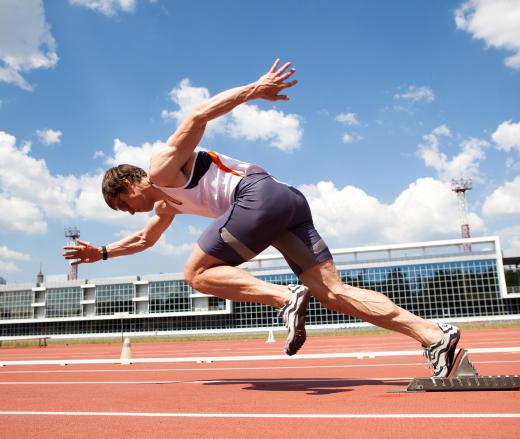Many types of track uniforms are available for track-and-field athletes. Uniform needs often depend on the specific track-and-field event. Athletes, such as sprinters, who compete in speed-based events, may be outfitted in aerodynamic, fitted wear. Participants in non-speed events may have less stringent uniform needs, but in general, lightweight, breathable materials are standard in track uniforms.
Most track events are held outdoors, often in hot weather. These conditions make comfortable, lightweight uniforms a must for athletes, to help wick away sweat and prevent the athlete from overheating. The most basic track outfit includes lightweight shorts and a sleeveless jersey. For track athletes who perform in more than one event, these standard uniforms provide versatility.

Sprinters or other runners may opt for a uniform that is different from a basic track outfit. Some runners wear a singlet, a one-piece, tight uniform that decreases wind resistance while running. Female runners may choose to wear short, underwear-like track bottoms to prevent any inhibition of leg movement. A variety of tops are available for runners, from fitted sleeveless tops to midriff tops for women. Deciding among these options may depend on personal or team preference rather than strong evidence for enhanced performance.

Shoes are one of the most important components of track uniforms. Various lengths of shoe spikes are available to runners, and choosing a spike length depends on the type of surface on which the runner will be competing. Sprinters generally prefer lightweight, thin shoes, as a high amount of shoe cushioning and stability are often not necessary for running short distances. Sports such as the pole vault and the long jump require specialty shoes with weights and spikes tailored to provide maximum performance in these events. Shoes for javelin throwers include more ankle support, to prevent injury to the thrower when he or she stops motion suddenly after launching the javelin.

Like most sports equipment, track uniforms vary widely in style and price. Smaller high schools may be able to afford only a basic jersey-and-shirt combination for athletes, while professional runners may choose uniforms in the most aerodynamic, high-tech materials available. Most track uniforms include some form of customization for the team, such as color, a team logo, or a name and number on the back of each team member's jersey. Professional athletes’ uniforms often feature their sponsors’ names or logos. Track uniforms are produced by a wide variety of companies, from large sportswear manufacturers to small, local shops.
